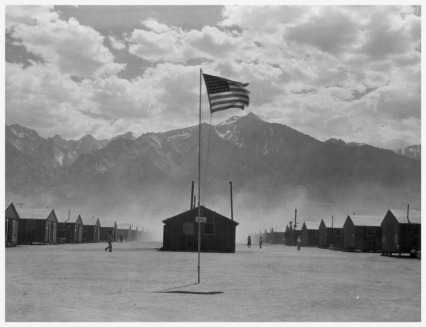Manzanar Project
Life At Manzanar:
Life in Manzanar:
Internees at Manzanar had to live in small one-roomed barracks that offered little privacy. The barracks that they lived in had holes in the walls, slits on the doors, and the flooring was bad so many insects and bugs came in during the night. Many nights, there was strong wind blowing up sand. This sand seeped through the holes in the floors of the barracks and made it an even worse enviroment to live. Owen's Valley was also a very dry and dusty area, causing their barracks to be soiled by sand. Here is what their life was like behind the barbed wire:
Life Behind the Barbed Wire:
After being relocated into the internment camps, the internees had to endure primitive, sub-standard conditions, and lack of privacy. They had to wait one line after another for meals, latrines, and the laundry room. Interners operated various services, such as the camp newspaper, beauty and barber shops, shoe repair, and more.
Food:
Unfortunately, not much was served at Manzanar. As we know, Japanese are customed to their own style of eating, it was not like this in camps. Internees at Manzanar had to wait in long lines for meals at the mess halls. Food at Manzanar was based on military requirements. Meals usually consisted of hot rice, vegetables, and cans of fruit. Their food was basically syrupy fruit over rice and some vegetables to the side, they had to eat this most of the time. Meat was scarce in the camps but the camp provided meat supplements for the prisoners' diet. The Americans that cooked the food did not know anything about the Japanese, so the Japanese-American citizens in Manzanar were upset and often had "Manzanar Runs". There were many laxatives in the food that they ate causing the latrines to be crowded.
Internees at Manzanar raised chickens, hogs, vegetables, and cultivated orchards for fruit. They even made their own soy sauce and tofu.
Internees at Manzanar raised chickens, hogs, vegetables, and cultivated orchards for fruit. They even made their own soy sauce and tofu.
Employment:
Most internees were employed at Manzanar to keep the camp running. Unskilled workers earned $8 per month, semi-skilled workers earned $12 per month, skilled workers made $16 per month, and professionals earned $19 per month. In addition, all internees received $3.60 per month as a clothing allowance. These job's included farming, nurses, and chef's. The Japanese that were chef's helped the American chef's by showing them how to cook, they were also paid money.

